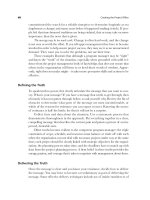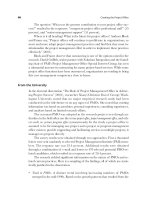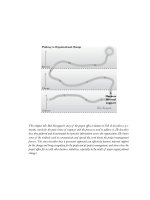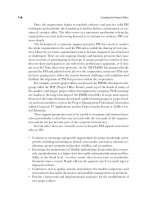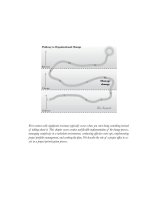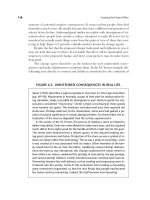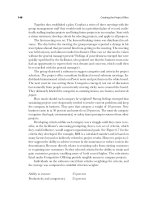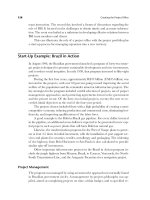Tài liệu Creating the project office 26 pdf
Bạn đang xem bản rút gọn của tài liệu. Xem và tải ngay bản đầy đủ của tài liệu tại đây (73.65 KB, 10 trang )
228 Creating the Project Office
FIGURE 9.3. PROJECT LEADER COMPETENCY MODEL.
Source: Robert Storeygard (1999), 3M.
Project
leader
Deliverable
enablement
Planning
of project
Project definition
Project objective and
situation analysis
Decision making
Development of plan
Communications
Contracting
Methodologies
Reengineering
Plan structure (WBS)
Risk assessment
Identify resource
requirements
Dependencies
Estimating time
and costs
Scheduling
Resource allocation
(Team selection)
Replanning
Reestimating
Validation of plan
Rescheduling
Appraisal
Motivation
Delegation
Guidance and
coaching
Trust building
Negotiation
Facilitation
Conflict resolution
Team building
Consultation
Listening
Written memos and
reports
Verbal and graphic
presentations
Interviewing
Risk analysis management
Decision making
Monitoring and tracking of plan
Communications
Change management
Contracting
Methodologies
Reengineering
Leadership
Coordination
Decision making
Communications
Legal and ethical
Restructuring
Group dynamics
Consultation
Marketing
Coordination
Decision making
Communications
Group dynamics
Legal and ethical
Marketing
Organizational adaptivity
Coordination
Decision making
Communications
Legal and ethical
Restructuring
Group dynamics
Controlling
the project
Interface
with
the team
Interface
with
the client
Interface
with
organization
People
proficiencies
attributes a successful project manager or leader needs. Associated skills include
things such as consulting expertise, risk management, decision making, and build-
ing professional and team relationships.
The initial guide to what it is to be a full-fledged, completely skilled project
manager or leader is best described by the Project Leader Competency Model
(see Figure 9.3). Novices get started in the discipline by attending project leader-
ship core classes. However, that is not enough. The associated classes, in many
cases, are just as important as the direct PM classes are to success as a project man-
ager or leader. When it comes to project failures, problems with soft (people-
related) skills are more often the problem than any lack of core PM skills.
Very little is prescribed in this curriculum in terms of sequence. Beyond the first
few classes, which provide the basics and are called “quintessential” classes, mod-
ules are taken at point of need or when people identify a weakness or lack that they
need to strengthen. Here is a sample listing of the Project Leadership Curriculum:
Building Core PM Understanding
• Project Management Basics
• Strategic Project Leadership
• Effective Technical PM (self-study)
PM Tools and Core Techniques
• PM Using MS Project
• MS Project: Basic, Intermediate, and Advanced
• Project Planning Workshop
• Gathering Complete Client Requirements
PM Methodologies
• Methodology for Small Projects
• PM Tools and Techniques
• Creating High-Performance Teams
Sharpening PM Skills
• PM Workplace Simulation
• PMI PMP Certification Test Preparation
Associated Support Skills
• Building Business Partnerships
• Systems Thinking
• Transition Management
In or Out? 229
Note that this corporate curriculum tries to leverage the “best of the best”
course offerings to meet the competency model, whether they are offered in-house
and taught by 3M instructors from various departments and divisions, or provided
by expert consultants and vendors from outside 3M. They have all been brought
together to forge a unified whole in helping people achieve maximum competency
as value-added employees and project managers or leaders for 3M.
Reflection
The 3M approach is a model for what the right people in this position can do to
make significant impact on the organization. The evangelists in the 3M Learning
Center are a small group that mobilize others in the organization. They extend their
impact by engendering enthusiasm in others through their example and the cur-
ricula they create and the programs they serve. Staffing and operating a learning
center with people of this caliber enables a very worthy change effort across the or-
ganization—leading to improved competence in project and program management.
Operating a Project Office:
EXFO’s Approach to New Product Development
Canada is the home for electro-optical engineering company EXFO (the name
derives from EXpertise in Fiber Optics). An interview with the VP of engineer-
ing, Stephen Bull, reveals an enlightened project culture.
Within the new product development process system, what makes up the project environment
axis?
At EXFO, new product development is a corporate affair not just a concern of
the R&D department. This means that all departments within the corporation
are involved at some stage in new product development projects. To ensure
success on projects, it is necessary to create an environment that will stimulate
the teams. This is done through clear assignment to projects from each depart-
ment and individual responsibilities for team members. Production pilot cells
are colocated with R&D to facilitate product transfer to production. Finally a
project manager is assigned to lead the project. Although coming from a tech-
nical background (but not generally the best technician), the project manager
is a specialist in project management. The PM has all the authority necessary
to coordinate the activities of resources assigned to his project from every
department.
230 Creating the Project Office
How did the project office get started?
The PMO started through the VP of engineering’s initiative with the purpose
of providing tools and project scheduling support to the project managers. He
did not and still does not want project managers to become specialists in sched-
uling tools or other reporting tools. He wants them to concentrate on manag-
ing the project, which is, 90 percent of the time, managing people.
What was the vision, who supported it, and why was it formed? Is the project office sup-
ported by the whole organization? Why?
At the start the PMO was envisioned as I just described it. The PMO is at-
tached to the R&D department under the VP’s direct supervision (necessary
to ensure its acceptance corporately). Since its inception, the PMO role evolved
along three axes:
Process keeper. The PMO through its manager is the keeper for the port-
folio and NPD processes. Responsibilities include rigorous application of the
processes, coordination of portfolio and gate reviews, and continuous improve-
ment of the processes.
Control center. The PMO team supports and provides project information
such as schedules, dashboards, metrics, and loading. It also provides portfolio
information such as resource usage and allocations, and overall metrics.
Competence center. Within the PMO, they have expertise to provide support
in project management. The PMO is responsible for defining and implement-
ing methodologies, standards, and tools. It also ensures the diffusion of best
practices and provides training on project management. Finally, it makes an
effort to promote project environment principles in other departments.
The PMO role today is strictly assigned to new product development.
They are now seeing interest from other departments in the usage of tools and
expertise within the PMO for their own functional projects.
Describe a typical role of the project office in the portfolio selection process.
Upper management does project selection and prioritization. The decisions
are mainly driven by market requirements, and priorities are adjusted with cor-
porate capacity. The PMO plays a coordination role and provides the data on
actual loading and last quarter project performances. It also builds compilation
graphs such as bubble diagrams and pie charts of all the projects being re-
viewed for analysis by the portfolio team.
In or Out? 231
Since the “PMO is the heart of the system,” what does it pump out across the organiza-
tion? What contribution does it make to implement projects? Does it have a significant role to
make any changes in the organization?
The PMO is a service center. It has a coordinating and counseling role. It has
no authority per se. The PMO manager is the owner of the processes, thus has
authority in the application of the processes. It is strictly focusing on new prod-
uct development.
How is EXFO weathering the current market situation? How has the PMO helped main-
tain success?
The current market situation is specifically difficult in the telecommunications
sector. EXFO’s strategy has been to concentrate efforts on new product devel-
opment. The company launched more than twenty new products in 2001, and
2002 will again be a record year for new products. The company anticipates
continued improvement due to market acceptance of important new products,
contributions from acquisitions, and expected gains in market share due to the
enhanced positioning of EXFO’s entire product line in the marketplace. Ger-
main Lamonde, our chairman, president, and CEO, says, “There’s no ques-
tion, these are unprecedented times in the telecommunications industry. We’ve
taken appropriate actions to deal with this current situation, while protecting
our long-term capabilities and intensifying our focus on gaining market share.”
The PMO performs an activity of visibility to projects. For example, the
PMO took the initiative to create a poster that shows all ongoing projects and
put it up throughout the company. That helped to inform the staff and align
everyone with their objectives.
What is management’s view of the project office? What is the vision for the future?
Eventually, the PMO will move to a corporate level, instead of a function level
(attached to R&D). Project managers will be attached to the PMO, who will
have the responsibility to assign them to specific projects. Eventually, one can
imagine that major corporate initiatives could be managed through project
management and be part of the PMO portfolio of projects.
Working Together
Other aspects of staffing and operating a project office are the effects people have
on each other when working together. Value conflicts often arise within a project
office or especially with its clients.
232 Creating the Project Office
